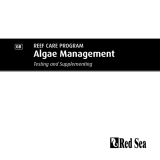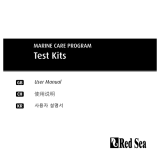
2 | Red Sea | Reef Care Program
optimal water parameters, a few of them have a more signicant role in the overall
stability. These elements are the foundation of the reef environment and they include the
three major elements: Calcium (Ca), Magnesium (Mg) and Bi-Carbonates (HCO3). These 3
elements have a major effect on the water chemistry (pH stability, Alkalinity, sea water
ionic strength) and on many of the coral’s biological processes (skeleton formation, ions
exchange, photosynthesis).
Coral Growth
Coral Growth (Skeletogenesis) is the process by which special cells within the corals soft
tissue, combine the foundation elements together with Strontium and Barium from the
surrounding water to form the building blocks of coral skeletons.
Corals build approximately 90% of their skeleton by combining Ca and CO3 ions from the
water to form Aragonite (CaCO3). The rest of the skeleton is made up from Magnesite
(MgCO3), Strontianite (SrCO3), Calcite (a more brittle crystal structure of CaCO3), Fluorite
(CaF2) and other minor and trace minerals.
In unbalanced conditions such as low levels of Mg and/or Sr the skeleton will develop
with a higher proportion of Calcite making it more brittle and more susceptible to
damage.
The foundation elements complement each other in the formation of coral skeleton and
if not available in the correct ratios one of them will quickly become the limiting factor of
healthy coral growth.
Elevated levels of the foundation elements create a more positive ionic pressure enabling
passive diffusion of the elements through the soft tissue making this process much more
efcient (less energy required per gram of skeleton). Therefore balanced elevated levels
of the foundation elements will result in accelerated coral growth rates.
When aiming to enhance coral coloration by reducing the levels of algae nutrients, lower
balanced levels of the foundation elements should be maintained.



















